
Fairfax Media closed the print edition of Business Review Weekly in November 2013 and then the BRW website also disappeared in March 2016.
That means today’s edition of the Rich List is the first produced from a standing start without the benefit of ongoing BRW-branded publishing.
It therefore comes as no surprise that the 2017 version has been rebranded as “Financial Review Rich List” and inserted into the monthly AFR Magazine.
As a keen collector of past BRW Rich 200 editions, it is worth doing a bit of a stock-take on what readers were served up in years gone by.
2000: $5 cover price for 228 pages with Neil Shoebridge as editor; 75 full-page advertisements and 150 pages of coverage. Kerry Packer way out in front on $8.2 billion, followed by Frank Lowy with $2.8 billion and Richard Pratt with $2.7 billion.
2001: $4.95 cover price for 196 pages with Neil Shoebridge as editor; 72 full-page advertisements and 118 pages of Rich List coverage. Kerry Packer on top with $6.2 billion, followed by Frank Lowy with $3.5 billion and Richard Pratt with $3.3 billion.
2004: $7.95 cover price for 196 pages with Tony Featherstone as editor; 43 full-page advertisements and 146 pages of coverage. Kerry Packer on top with $6.5 billion, followed by Frank Lowy on $4.2 billion and Richard Pratt also on $4.2 billion.
2006: $7.95 cover price for 196 pages with Tony Featherstone as editor; 43 full-page advertisements and 148 pages of coverage. James Packer on top with $7.1 billion, followed by Frank Lowy on $5.4 billion and Richard Pratt on $5.2 billion.
2009: $9.95 cover price for 156 pages with John Stensholt as editor; 31 pages of ads and 120 pages of coverage. Anthony Pratt on top with $4.3 billion, followed by Frank Lowy on $4.2 billion and Harry Triguboff with $3.66 billion.
2010: $9.95 cover price for 148 pages with John Stensholt as editor; 28 pages of ads and 110 pages of coverage with nothing else in there but Rich List material. Frank Lowy was on top with $5.04 billion, followed by Gina Rinehart at $4.75 billion and Anthony Pratt at $4.6 billion.
2011: $9.95 cover price for 148 pages with Andrew Heathcote as editor; 34 pages of ads; 110 pages of coverage solely focused on the Rich 200. Gina Rinehart on top with $10.3 billion, followed by Ivan Glasenberg with $8.8 billion and Andrew Forrest with $6.18 billion.
2013: $11.95 cover price for 124 pages with James Thomson as editor; 26 full-page advertisements and 98 pages of coverage. Gina Rinehart on top with $22.02 billion, followed by Frank Lowy on $6.87 billion and James Packer on $6 billion.
The 2017 edition was edited by John Stensholt and you could pick it up by paying $4 for the AFR. Anthony Pratt soared to the top with an estimated wealth of $12.6 billion, followed by Harry Triguboff on $11.45 billion and Gina Rinehart with $10.41 billion.
The printed Rich List is a 40 page lift-out inserted into the monthly AFR Magazine, which runs to 76 pages, for a total of 116 pages.
Across both publications there is 54 full-page advertisements and 43 pages of Rich List coverage, although remember that the pages are about 20% larger than the old BRW in the AFR Magazine format.
The actual Rich List coverage is pretty thin this year. Each of the 200 rich listers get a perfunctory 100-word description, plus readers are told their age, city of residence, estimated fortune and industry.
The main news piece on Anthony Pratt had some interesting quotes but was compromised by the disclaimer: “John Stensholt travelled to the US as a guest of Pratt Industries.”
The Matthew Stevens cover story on Jac Nasser for the AFR Magazine was in the same camp: “Matthew Stevens travelled to New York as a guest of BHP Billiton.” It talked about Nasser doing fundraisers to help the Great Barrier Reef, but failed to mention the role Rupert Murdoch’s 21st Century Fox plays as the most powerful corporate propagandist for climate scepticism on the planet right now. Nasser is a director.
In terms of Rich List break-out stories, there was a solid Anne Hyland piece on Carol Schwartz, although it focused more on her gender campaigning than wealth.
Five rich listers — Jonathan Hallinan, Imelda Roche, Yenda Lee, Shesh Ghale and Graham Turner — outlined their daily routines and there was a piece on those servicing wealthy Chinese Australians and Chinese investors.
Throw in a lengthy feature on newly minted billionaire Terry Snow, who got rich buying Canberra Airport for a song off the federal government in the 1990s, and that was about it.
Is Fairfax making a profit out of Rich List? Maybe, although the standalone used to sell for months, whereas the version available in today’s AFR will have disappeared when the Weekend Fin arrives tomorrow. My newsagent said he got 20% more AFRs than usual today and a few posters to promote the Rich List.
Fairfax is doing far less Rich List coverage throughout the year than in earlier days, so you would think its franchise would be vulnerable to someone running an online Rich List version with regular updates and a revenue stream augmented by conferences and speaking gigs.
Maybe one or two of the upcoming Fairfax journalistic redundancy cheques could be invested in such a venture, because the grand old dame of Australian publishing isn’t doing much of a job after 34 years of producing an annual Rich List.
Alternatively, the break-up merchants in private equity land currently circling Fairfax might be prepared to sell the Rich 200 name, database and archive for a couple of million.
It would make sense to give it home where people really care about the quality of the product. For instance, the AFR also had a 68 page glossy Domain lift-out inserted in today’s paper.
If Fairfax wanted to maximise the reach of the Rich List, why not also insert it into The Age and the SMH, as occurs with Domain. Truth be known, the content isn’t strong or unique enough to draw the advertising that would justify the additional printing and distribution expenses.








What sort of ranking would there be on the Australia 200 rich list, if there was another column outlining Australia 200 top taxpayers.
In Japan certainly, and I think also Norway, the nation’s top individual taxpayers are honoured to be so publicised.
Dif’rint strokes, dif’rint soaks.
Bill Hilliger: Giggle, giggle, ¡OUCH! Screams of laughter.